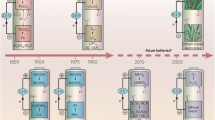Abstract
A new organic–inorganic hybrid polymer, poly(n-butylamino) (di-allylamino) phosphazene, is synthesized and electrical properties of the polymer are reported. From the results of Fourier transform infrared (FTIR), 1H-nuclear magnetic resonance (NMR) and 31P-NMR measurements, it was confirmed that the synthesized polymer was poly(n-butylamino) (di-allylamino) phosphazene. From an Arrhenius plot of d.c. conduction it was found that experimental points fit to two straight lines, that the discontinuous point could be the glass transition (Tg=268.9 K) and that the activation energies are 0.74 and 1.5 eV at temperatures higher and lower than Tg, respectively. Dielectric constant and dielectric loss factors were measured over the temperature range from −20°C to 70°C with frequency 100 Hz∼100 kHz, and a dielectric loss contour was obtained. A relaxation process with the activation energy of 1.44 eV was found from the dielectric loss contour, which can be attributed to α relaxation. A comparison was made between the present results and those of other phosphazene polymers. Because the polymer was non-flammable and shows high resistance and low dielectric constant, it could be used as an insulator in the field of electronics. © 1998 Kluwer Academic Publishers
Similar content being viewed by others
References
R. A. ALLCOCK and R. L. KUGEL, J. Amer. Chem. Soc. 87 (1965) 4216.
P. M. BLONSKY, D. F. SHRIVER, P. AUSTIN and H. R. ALLCOCK, ibid. 106 (1984) 6854.
S. COHEN, M. C. BANO, L. G. CIMA, H. R. ALLCOCK, J. P. VACANTI, C. A. VACANTI and R. LANGER, Clin. Mater. 13 (1993) 3.
M. KAJIWARA and T. KIMURA, J. Mater. Sci. 31 (1996) 5457.
T. KIMURA, J. Mater. Sci. Idem. ibid., 31 (1996) 6659.
T. HAYASHI and H. SAITO, Bull. Chem. Soc. Jpn. 50 (1977) 1023.
I. MURAKAMI, H. OCHIAI, K. TOMINAGA and M. KAJIWARA, J. Inorg. Organomet. Polym. 2 (1992) 255.
T. KIMURA and M. KAJIWARA, ibid. 2 (1992) 431.
Idem., Polymer 36 (1995) 713.
P. D. MARO, G. GIRO, S. LORA and M. GLERIA, Mol. Cryst. Liq. Cryst. 118 (1985) 439.
H. R. ALLCOCK and T. X. NEENAN, Macromolecules 19 (1986) 1495.
M. M. LERNER, A. L. TIPTON, D. F. SHRIVER, A. A. DEMBEK and H. R. ALLCOCK, Chem. Mater. 3 (1991) 1117.
H. R. ALLCOCK and D. P. MACK, Chem. Commun. (1970) 685.
H. R. ALLCOCK, R. L. KUGEL and K. J. VALAN, Inorg. Chem. 5 (1966) 1709.
Author information
Authors and Affiliations
Rights and permissions
About this article
Cite this article
Kimura, T., Kajiwara, M. Electrical properties of poly(n-butylamino) (di-allylamino) phosphazene. Journal of Materials Science 33, 2955–2959 (1998). https://doi.org/10.1023/A:1004354713896
Issue Date:
DOI: https://doi.org/10.1023/A:1004354713896




